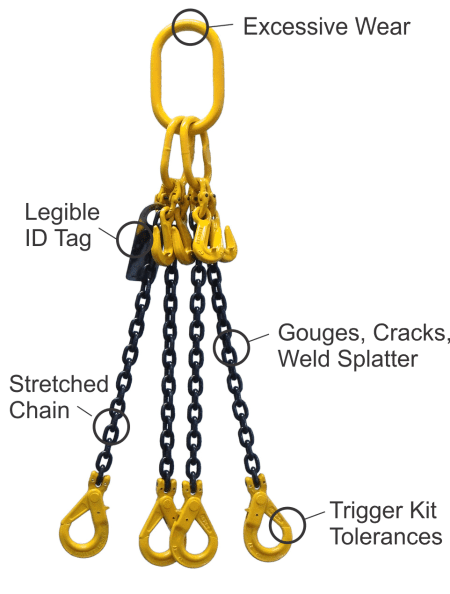Chain Sling Inspection, Test, Maintenance and Certification
Chain slings are some of the toughest pieces of rigging equipment, but even the toughest gear needs to be inspected, tested, and certified every year.
Hercules Crane and Lifting Supplies' ASME certified inspectors are available to complete chain sling inspections and certifications across Canada. Regular chain sling service is more than just smart business, yearly certifications are required by Canadian law.
All inspections are carried out in accordance to ASME standard B30.9.
For chain sling inspections, load testing, repairs and certifications contact the chain sling service experts at Hercules Crane and Lifting Supplies today.
Why is the chain sling inspection important?
When used in rigorous material handling applications, chain can easily become worn or corroded.
It is important to inspect chain for defects on a regular basis to avoid an unsafe lifting condition or even operator injury. When corrosion and wear occur, it results in a reduction of link cross-section which can lead to decreased strength of the chain.
Corrosion can occur anywhere chain comes in contact with harsh chemicals, water or when it is used in tough environments. Wear can occur in any portion of a link that is subject to contact with another surface.
Chain Sling Inspection and Certification

Frequently Asked Questions
- Normal Service: once annually
- Severe Service: once monthly to quarterly
- Special Service - as recommended by a qualified person
Intervals between inspection should never exceed one year. Written records are not required for frequent inspections, however written records should be kept. The WSTDA, RS-1 and ASME B30.9 require written record of the latest inspection.
- All slings (new, altered, modified, or repaired) should be inspected by a trained user a competent person before they are used in the workplace.
– Need to be inspected and documented once a year by a competent person
Before attempting a lift operation, be sure you know how to operate the equipment and sling techniques appropriately. Inspect the slings and accessories before use for any defects.
– Replace any safety latches that have any damage.
– Before lifting, determine the weight of the load. Do not exceed the sling’s rated load.
– Check whether chain slings fit freely. Do not force, hammer or wedge chain slings or fittings into position.
– Keep hands and fingers from between load and chain when tensioning slings and when landing loads.
– Ensure the load is free to be lifted.
– Make a trial lift and trial lower to ensure the load is balanced, stable and secure.
– Balance the load to avoid overstress on one sling arm or the load slipping free.
– Pad sharp corners to prevent bending links and to protect the load.
– Position hooks of multi-leg slings facing outward from the load.
– Reduce the load limit when using chains in temperatures above 425°C (800°F).
– Store chain sling arms on racks in assigned areas and not lying on the ground. The storage area should be dry, clean and free of any contaminants which may harm the sling.
Customers can come to one of our shops across the country or we can come to you with our Mobile Testing Unit. Technicians at Hercules SLR are trained and certified with LEEA accreditation. All inspections are completed within ASME standards.
Still Have Questions?
Whether you have a specific question, need help with booking your service or just want to chat with an expert, we're here to help. Give us a call today!
1 877 461 4876
You can also contact us by email by clicking the button below.





